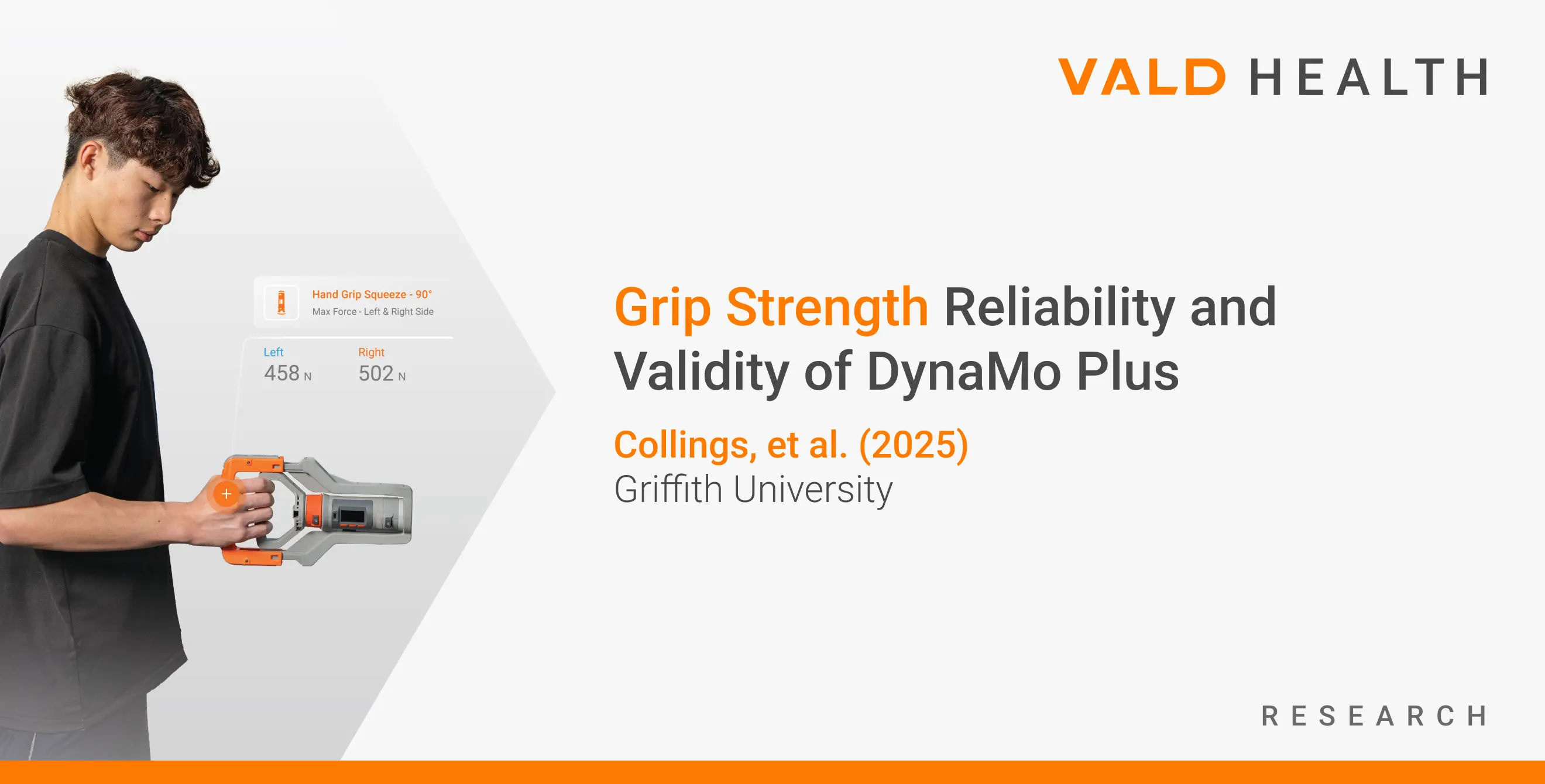Grip Strength Reliability and Validity of DynaMo Plus
Available in:
EN
Study Information
Collings, T. J., Goodlich, B., Hams, A., & Bourne, M. N. (2025). Reliability and validity of DynaMo Plus for hand grip strength assessment: A comparison with the Jamar dynamometer [Unpublished manuscript]. Australian Centre for Precision Health and Technology, Griffith University.
Purpose of the Study
Hand grip strength is a well-established indicator of overall strength and general health. The Jamar hand dynamometer has long been considered the reference standard for measuring grip strength, with strong evidence supporting its test-retest, inter-rater and intra-rater reliability. However, it lacks many of the features offered by modern digital devices, such as longitudinal data capturing and integration with normative datasets, as seen in next-generation tools like DynaMo Plus.
To understand how it compares against the benchmark, this study aimed to assess the reliability of DynaMo Plus for grip strength testing and compare its performance to the Jamar handheld dynamometer.
Methods
The study included 20 healthy participants (60% male, 40% female, aged 21-43) who completed two identical testing sessions approximately seven days apart. Each participant performed three trials with each device, using randomized order for DynaMo and Jamar, with grip strength assessed in the neutral test position.
Protocol video demonstrating the neutral test position.
Within-day and between-day consistency was assessed using Standard Error of Measurement (SEM), Coefficient of Variation (CV) and Intraclass Correlation Coefficients (ICCs). ICCs were interpreted using standard thresholds:
- <0.50 indicate poor reliability
- 0.50 to 0.74 indicate moderate reliability
- 0.75 to 0.89 indicate good reliability
- 0.90 to 1.00 indicate excellent reliability
Results from DynaMo were converted to kilograms (kg) by dividing results in Newtons (N) by gravity (9.81) for direct comparisons. Agreement was assessed between devices using the coefficient of determination (R2), a Bland-Altman plot with mean bias and 95% limits of agreement.
Key Findings
Within-day reliability of the DynaMo Plus was excellent (ICC = 0.98), and between-day reliability also showed excellent consistency (ICC = 0.97) …[indicating] strong test-retest precision.
Reliability
Within-day reliability of the DynaMo Plus was excellent (ICC = 0.98; SEM = 29N; CV = 6.6%), and between-day reliability also showed excellent consistency (ICC = 0.97; SEM = 29N; CV = 6.7%). These values indicate strong test-retest precision. DynaMo Plus and Jamar demonstrated similar between-day reliability, although DynaMo showed slightly higher SEM and CV (Figure 1).
Figure 1. Comparison of between-day reliability metrics for DynaMo Plus and Jamar hand dynamometers. ICCs (top), SEM (middle) and CV (bottom) for both devices. Error bars represent 95% confidence intervals.
The linear regression (Figure 2) shows a strong positive relationship between grip strength measured by DynaMo Plus and the Jamar dynamometer (R² = 0.89, p <0.001).
Figure 2. Scatterplot showing the relationship between grip strength values recorded using DynaMo Plus and the Jamar handheld dynamometer. A linear regression line is fitted with 95% confidence intervals (shaded area). Dashed lines represent the amount of trial-to-trial variation, and because measures were not taken concurrently between devices, any difference falling outside the dashed lines is purely due to repeat effort variation.
The mean difference between grip strength recorded from DynaMo Plus and Jamar was 0.1kg, which indicates excellent agreement (Figure 3).
The Bland-Altman plot confirms the absence of systematic bias, with the mean difference close to zero and 95% of data points falling within the ±7kg limits of agreement. The spread of data indicates the expected trial-to-trial variability of repeat trials with different devices and no proportional error. DynaMo is neither consistently higher nor lower across the full measurement range.
Figure 3. Bland-Altman plot illustrating the agreement between DynaMo Plus and Jamar grip strength measurements. The plot shows the difference between devices against their average, with horizontal lines representing the mean difference and the 95% limits of agreement. Shaded regions represent the 95% confidence intervals.
VALD’s Solution
DynaMo Plus provides a reliable and validated solution for grip strength assessment across clinical and performance settings. Peak grip strength measured using DynaMo Plus closely aligned with those obtained from the Jamar dynamometer, the longstanding reference. While minor variations may occur across individual participants, consistent adherence to testing protocols should ensure measurements of grip strength are similar between devices.
Importantly, DynaMo Plus meets the same reliability benchmarks established in the literature (Bellace et al., 2000; Hamilton et al., 1994; Roberts et al., 2011), confirming its suitability for ongoing clinical use and high-performance environments.
By combining robust reliability with the modern advantages of DynaMo, such as digital data capture, longitudinal tracking and seamless integration with the VALD ecosystem, DynaMo Plus represents an accurate, reliable and future-ready alternative to traditional grip strength tools.
If you would like to know more about how to integrate VALD’s human measurement technology into your organization for enhanced assessment and decision-making, please reach out here.
